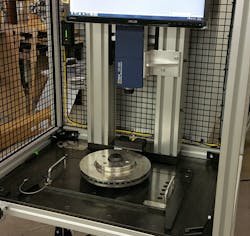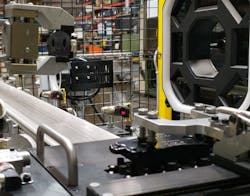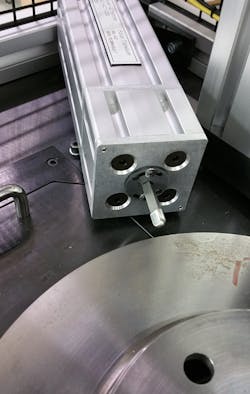Subjective Quality Testing is Becoming a Thing of the Past
What comes to mind when you look at your automobile, washing machine, lawn mower or any other product? For many, it’s the manufacturer’s name attached to that product. And to protect their brand, reputation, and market share, those manufacturers are increasingly diligent about quality. And for an OEM, that includes all Tier 1 and Tier 2 suppliers.
Christopher Kus, project engineer and NVH expert for the Automotive Seating Business Group-NAO of Faurecia, explains that consumers rarely differentiate between the system and its components.
"Sub-system and component flaws generally create overall negative feelings toward the system as a whole," said Kus. "For example, a rattling window, unreliable ventilation fan or noisy seat motor will result in a reputation for poor quality for the entire vehicle. Consequently, OEMs are increasingly vigilant with supplier quality."
Faurecia Seating seat systems optimize the comfort and safety of occupants while offering premium quality to its customers. By objectively quantifying quality, Faurecia is meeting and exceeding customer (and end-user) expectations.
"Throughout manufacturing there’s no time for detailed laboratory quality testing. As a result, companies generally rely on a Pass/Fail or Red Light/Green Light inspection process," explained Kus. "To get to that point we take subjective, often vague, input from the customer to create objective quantifiable metrics. We begin with subjective jury evaluations to determine a rating of specific noises. From the results we can use statistical methods to choose what psychoacoustics best can be used to describe how the human ear perceives sounds of the specific source. From there statistical methods are used to create an algorithm to correlate to the rating system of the human ear subjective ratings."
The Challenge: Eliminating Subjectivity
Relying on the judgement of even the most experienced quality inspectors to determine what is acceptable (or not) as products roll off the production line creates opportunity for errors. When human emotion is involved critical decisions, results can vary from one inspector to the next or from one day to another.
But removing subjective interpretation from the equation is not always easy. For example, supplier requirements might call for the product to satisfy any number of specific design and performance parameters and be free of other objectionable noises. But how does one quantify what is objectionable?
Fortunately, technology has emerged that allows suppliers to inspect every part that they manufacture to identify flaws and ensure conformance to rigid specifications.
The Answer: Automating Objectivity
Quality inspection must be repeatable, consistent, metrics-based, and above all "objective." Faurecia, and many other suppliers, rely on automated end-of-production quality inspection technology from Signalysis, a provider of testing systems, to verify that parts are defect-free.
The thorough, highly technical and systematic approach begins by gathering customer specifications. This could be anything from specific failure modes—such as ticking in a motor, excessive noise or rattling, modal parameters for rotors or an OEM’s general specification to the non-descript "other objectionable noises" catch-all.
The next step is to acquire baseline data on a sample of parts to help quantify and differentiate acceptable from non-acceptable. Ideally these test parts represent the full range for each failure mode including those that do not meet quality standards, borderline parts and acceptable parts.
Signalysis' physics-based SigQC™ software powers these systems and decisions. The measurement hardware (data acquisition devices, sensors, triggers and timing) along with the proper setting of measurement parameters drives the quality of the data. A robust and versatile software toolbox of functions and data management is the key to designing the perfect objective quality testing algorithm.
The sequence of actions used to create a production sequence is completely customized and can be made unique for any customer. A database of acceptance tests with complete description of products, test setups and pass/fail specifications is available for automatic access. As a product arrives to the test station, a bar code scanner or keyboard entry provides the information needed for automatic selection and initiation of the acceptance test. Upon test completion, the unit automatically receives a pass/fail quality grade. The data for the unit under test is displayed on screen; but it can also be to customer servers or an in-house data display program.
Implementation Challenges
Signalysis engineer Robert Cagle explains that one of the biggest challenges is that the laboratory or theoretical data is rarely the same as end of line testing, and everything else is a symptom of that. What can be calculated on paper is rarely seen in experimental data exactly as one expects it will come to fruition.
Sometimes lab data might have been collected in an anechoic (i.e., free from echo) chamber with microphones. This isn’t conducive to the production line tester that is being developed without a sound chamber and can lead to the issue of buy-in from suppliers and OEMS. This is mainly due to the lack of understanding that what we hear in microphone data is what we are feeling from vibration data taken with an accelerometer or laser vibrometer.
"Automated objective testing is a break from the norm for some and there is nearly always an adjustment period to implement objective quality testing," said Cagle. "The massaging of metrics and tolerance limits in that transition can sometimes cause headaches and frustration. When this is the case, the user may be tempted to turn the machine off and revert to more subjective testing methods. However, the key to long term success is to understand and trust the process. A little patience at the beginning will yield measurable quality improvements."
The Product Lifecycle
While end of production testing is important, it’s just one area when quality should be assessed. Implementing quality testing from concept through production helps to ensure that flaws are identified as the product passes through each product development stage gate. This significantly reduces the number (and associated cost) of rejected parts being tossed on the scrap pile.
But what about products with inherent flaws that do not surface until the product is in use?
Portable test systems isolate problem areas after the product reaches the final customer. This enables problems to be quickly identified and corrected while relaying vital information back to the supplier for the design of next generation products.
The Bottom Line
Today’s competitive supply chain landscape is crowded with would-be suppliers just waiting for an opportunity to pounce. There is nothing more dangerous than to have the quality of one’s work brought into question. When it comes to product quality, there’s no place for guesswork, subjectivity or trial-by-error engineering.
Objective quality testing is rooted in science and generates results that are measurable, consistent and repeatable. When embraced the results are sustained improvements to quality, cost-reduction and ultimately the bottom line.
This article originally appeared in Power & Motion, an affiliate publication to Machine Design.



